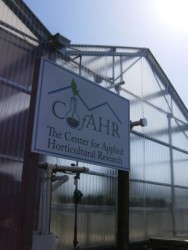Center For Applied Horticultural Research: Do-It-Yourself Research

Most growers would tell you they understand the importance of horticultural research. Ken and Deena Altman take the discussion to an entirely new level. In fact, the Altmans, owners of Top 100 Grower Altman Specialty Plants, believe so strongly in the subject, they’ve decided to do it themselves. Last October, they announced the creation of the Center for Applied Horticultural Research (CFAHR).
The center–a one-acre facility donated by the Altmans including indoor and outdoor growing facilities, a lab, and a conference room– will strive to improve production at Altman Plants, of course. But it won’t stop there. The center’s ultimate objective is to conduct research that will help all growers produce better plants, decrease costs, and maximize profits.
“I’ve seen some of the great results that come from research John Erwin from the University of Minnesota has helped us with, for example. Also, in California we have a really huge industry with very few places to come together,” Ken Altman says.
“All of these things, plus my enjoyment being around people who are thinking about what’s next and advancing the field made me think this would be a great opportunity to bring growers and researchers together.”
Everyone Contributes
Work at the center isn’t intended to replace the research already being conducted by university Extension and other groups. It’s meant to “fill in the gaps” in support of that research, Altman says.
The beauty of the concept, says Center Director Lucia Villavicencio, is CFAHR can identify specific grower needs and address them quickly, rather than hope to match their problems with someone else’s research priorities.
“At the grower level, it’s often hard to test scientifically what kind of methods can be used to grow plants better. When you have a problem you can always go to the farm advisors, but it’s hard to test in your own operation. You might have an idea about a solution, but it’s difficult to test it scientifically,” she says.
Villavicencio, who has a Ph.D. in plant physiology from North Carolina State University, will oversee daily operations and conduct research, but she won’t be alone. The CFAHR is designed to encourage an open collaboration on ideas. The center is dedicating lab space for a field office for Jim Bethke, University of California (UC) Floriculture and Nursery Farm Advisor in San Diego County. Its lab and greenhouses also are open to other research professionals. And ideas for projects can be submitted by anyone in the industry.
“Ken’s idea was to have this center for research for other growers and for the scientific community too,” she says. “We have UC-Riverside nearby and there are colleges in the area. We hope researchers there will see us as a resource they can use.”
The CFAHR website has a proposal form for people in companies, universities or colleges who want to conduct applied research, but don’t have the resources, the space or the help to do so. Applicants indicate how much time and space they need, any special conditions required, and the types of plants they are going to grow. The center donates use of the space for approved projects.
Research requests can come from others in the industry as well, Villavicencio says. “We want to encourage other growers to come out and say, ‘I have this problem. Is there anything we can do?’ We have an Idea Submission form on our website they can fill out. That way we can work together and do something about it.”
Addressing Real Needs
The ultimate mission of the center is to help the industry as a whole. That means all information gleaned from the research will be available to anyone who is interested.
“The results of our research will be publicly displayed,” Villavicencio says. “We will have open houses, and we are planning a newsletter. I personally want to publish in trade magazines or scientific journals, too.”
Fulfilling that mission means there won’t be many restrictions on the types of studies done at the center. “Research has to benefit the local ornamental horticulture industry, and nurseries in general,” she says. “That’s about the only guideline we have right now.”
Villavicencio hopes research will run the gamut of challenges growers have to deal with. “With the kind of water shortage the industry is facing, studies on irrigation efficiency would be great. I think we’d look at plant growth regulators or regimes and types of fertilizers. I would also like to see a little bit on organic production, and more natural practices designed to reduce the use of pesticides,” she says.
The center will also be open to new trends and challenges as they arise. “We’re not limited to ornamental plants. A lot of nurseries are growing vegetables now, so that’s a possibility too.”
Research began at the center last fall and a number of projects are already underway or nearing completion (see Hard At Work). Up to this point, CFAHR has been completely supported by the Altmans. “We’re trying to identify sources for becoming more independent,” Villavicencio says, however. “We have been very lucky so far. There’s a need for research and when we have needed plants we have been able to obtain them. But we’re just starting out, and we are open to any help. And we want to hear ideas coming from everyone who is involved in this industry,” she says.
They’re off to a good start. “The support that we’ve gotten from the company and the welcome from everyone in the industry has been wonderful, and the facility is coming along really, really nicely,” Villavicencio says. “I believe we can make a difference.”









